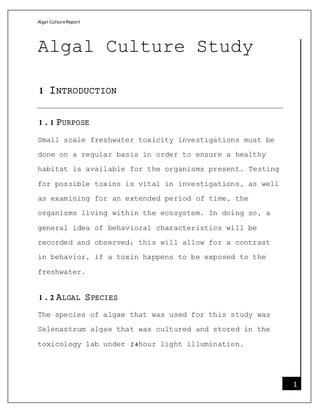This document summarizes an algal culture study conducted from January to April 2015. Selenastrum algae was cultured under 24-hour light at a light intensity of 1000 lux. The algae was exposed to various concentrations of copper to determine the algistatic concentration. The tubes were shaken daily to keep the solutions homogenized. While the results were variable and inconclusive, toxicants like copper have the ability to inhibit algal growth in ecosystems.




![Algal CultureReport
4
3.4 FIGURE 1.1
3.2 [CU]
{MG/
L}
3.3 TUBE # CELL DENSITY (CELLS/ML) AVG
(F/I)
FOR 2
TUBES
LOG OF AVG
(F/I)
INITIAL FINAL RATIO OF
F/I
0 1:0.182
2:0.174
1.41 X
107
1: 3.03
X 10-10
2: 2.8
x 10-10
1: 0.0021
2: 0.0020
0.00205 -2.688
0.5 1:0.184
2: 0.164
1.41 X
107
1: 3.06
X 10-10
2: 2.73
x 10-10
1: 0.0022
2: 0.0019
0.00205 -2.688
1.0 1: 0.141 1.41 X
107
1: 2.35
X 10-10
1: 0.0016
2: 0.0019
0.00175 -2.757
y = -0.0361x - 2.7127
R² = 0.4078
-2.77
-2.76
-2.75
-2.74
-2.73
-2.72
-2.71
-2.7
-2.69
-2.68
-0.4 -0.2 0 0.2 0.4 0.6 0.8 1 1.2
log(finaldensity/initialdensity)
log[Toxicant]
Toxicant VS F/I](https://image.slidesharecdn.com/75141e35-89bb-440e-92f3-02121636532b-160405011041/85/Algal-Culture-Study-5-320.jpg)


